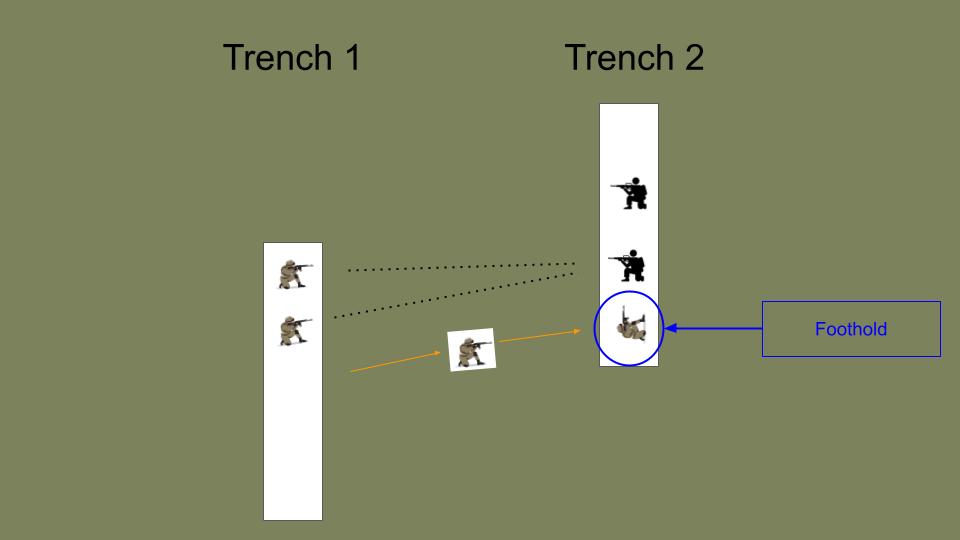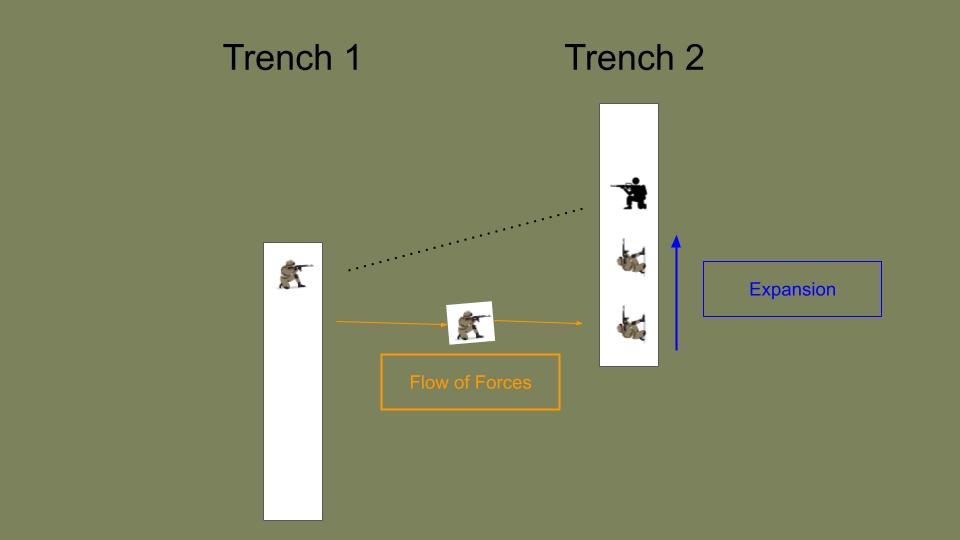SUMMARY
-
Don’t commit too many resources before you have established a foothold.
-
When establishing the foothold make sure the team is well-supported.
WAR
Imagine that you are a Marine squad leader with 11 infantry Marines reporting to you. Your entire squad is currently in a trench with good cover with minimal risk from gun fire. Your next task is to take a trench which is 75 yards away, over open ground, and held by the enemy.
What would be your approach to this problem?
In the infantry, the solution to this problem is to gain a foothold in the next trench and start expanding that foothold.
A foothold is a small area in enemy territory under your control. At a micro level, this could be part of a trench or a room in a building. At a macro level, it could be an airport or beachhead. The enemy controls the rest of the area but once you have a foothold you can start expanding.
Note: In this article, I will be giving examples of a trench but it also applies to the other scenarios.
Foothold process
To gain a foothold you need to:
- Identify the weak point you want to penetrate.
- Suppress the enemy to isolate that point and allow for troops to move to it safely.
- Send the minimum amount of people to gain an initial foothold.
- Quickly flow forces to expand the foothold.
The process is to mass as much support as possible on a single point to allow for a breakthrough then to expand that breakthrough by flowing resources into it.
Identify a point and suppress
To gain and expand a foothold, you first need to identify the best point in the enemy defenses to penetrate. That point is ideally physically close to where you are and not well-defended. Once that point has been identified and communicated, you then work to isolate it from the enemy.
To isolate the penetration point, you coordinate as much firepower as possible on the enemy who is guarding that location. This firepower will force the enemy’s heads down, not allowing them to effectively shoot at your troops, who will be moving to gain the foothold.

To bring all of your firepower down on a location, you’ll likely need to reorganize and reorient your troops. This will take direct leadership and communication to get everyone’s weapons oriented to the right locations. They will then need to know when to start suppression, so that it aligns with the sequencing of troop movement to take the foothold.
Imagine literally walking through the trench telling your squad where the penetration point is, who will be suppressing the enemy to isolate that point, when they need to start suppression and who will be making the first rush to take the foothold.
Gain a foothold
After identifying the point of penetration and isolating it through suppression, it’s now time to gain a foothold. To gain a foothold, you need infantrymen to move across the open ground and physically take a small piece of the trench.The purpose is to take enough space so that more people and resources can flow into the foothold and start expanding your control.
Sending the correct number of people to gain the foothold is a critical decision. If you send too many people, they all could get wounded or killed before making it to the trench. If you send too few, then they may not have enough firepower to actually gain the foothold once they get there.
Ideally you should send the fewest people possible that can establish a foothold in the trench. Knowing this number will be a judgment call by the leader on the ground. Will it be two people, four, six or even more? Guessing that correct number will take experience and an analysis of the tactical situation.

Continuing with our trench example, after your analysis you decide that two infantrymen followed quickly by two more, for a total of four gaining the foothold, is the appropriate number of people. If all four of them were to get wounded or killed, you would still execute the mission and if they get there safely, they should have enough firepower to take part of the trench.
Once you’ve taken the foothold, you then start flowing resources to it.
Flow of forces
To flow forces is to send people and resources to the foothold to fortify it and then to start expanding. With sending the fewest people to initially gain the foothold, they won’t be able to hold that position long without support. The enemy will quickly counter attack to unseat them from the foothold. It is critical to have resources prepared to move quickly to fortify and prepare to expand the foothold.
The speed of flowing forces to the foothold is critical to its success. You should have people and assets standing by ready to reinforce, once it’s clear the foothold has been established. If you are not prepared to push resources to the foothold, then you should not commit to taking it.

The purpose is to fortify the foothold to prepare for further expansion.
Keep expanding control
You will have enough people to keep the foothold secure and to start clearing the rest of the trench of any enemy threats. Once the trench is completely clear, that objective is secure. You will then repeat the entire ‘gain a foothold’ process for the next trench that you are tasked with securing.
The foothold process is a methodical way to take control of key terrain features from the enemy. It is used at the smallest level to take a room or a trench and at the largest levels in an invasion taking entire islands at a time.
BUSINESS
The process that is used to gain a foothold in combat is the same process that is used by an entrepreneur to start a business or by an established company to move into a new market.
At a high level that process is:
-
- Identify a problem that needs to be solved.
- Analyze the current competitors solutions.
- Create a minimum viable product (MVP) to gain an initial foothold.
- Quickly improve that product to increase market share.
A quick example would be an Amazon product that I’ve personally been working on launching.
-
- Identify a problem: During the COVID lockdowns, I was doing a lot of high rep burpee and calisthenic workouts. One frustrating part of these workouts is that you lose count of how many sets that you’ve done. I also experienced this problem when I was doing a lot of Crossfit. To me this was a problem worth solving and one that I think could help a lot of people enjoy their workouts more.
- Analyze the market: I spent a few weeks searching for a product that would count my workout sets for me. I found one suitable crowdfunded product that didn’t seem to have ever launched. None of the other counters on the market would work for workouts.
- Create an MVP: I then went to work on getting a prototype made. I sent my specifications to a manufacturer on Alibaba, They 3D printed a product. I then ordered a small batch of 100 of the finished round counter to start testing some marketing and getting feedback.
- Improve product and scale: At this point I have a final product and will be looking to order my first full run. Once I have those, I will be working to sell them as hard as I can. Creating sales channels will be my top priority.
This is a personal example of how I used the principles of gaining a foothold to create a new product and start to gain space in a market.
Conclusion
Launching a new product or business follows the same principles as taking a trench in combat.
The key considerations are:
- Where exactly are we doing to focus our limited resources?
- What is the right amount of resources to attack this problem?
- You don’t want to over or under commit
- This takes judgment which comes from experience and/or detailed planning
- If I get something established, will I be able to commit more resources to continue to gain ground?
The principles of war and business will always be the same.

0 Comments